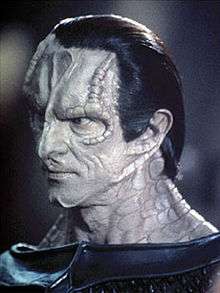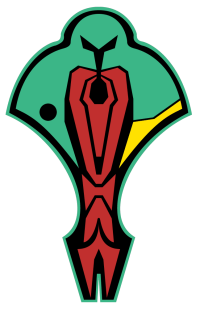Cardassian
The Cardassians (/kɑːrˈdæsiənz/) are a fictional extraterrestrial species in the American science fiction franchise Star Trek. They were devised in 1991 for the series Star Trek: The Next Generation before being used in the subsequent series Star Trek: Deep Space Nine and Star Trek: Voyager.

The writers of The Next Generation introduced the Cardassians for the fourth season episode "The Wounded". The species was devised to be new antagonists for the crew of the USS Enterprise-D, ones with whom the protagonists could interact; the other major antagonists of The Next Generation, the Borg, lacked personality or individuality, hindering interpersonal drama. In the series, which is set in the 24th century, the Cardassians are presented as living under a military government controlling an interstellar empire, the Cardassian Union. They are depicted occupying other planets, most notably Bajor. When the spin-off show, Star Trek: Deep Space Nine, was launched in 1993, its writers set its events in the vicinity of Bajor in the aftermath of the Cardassian occupation. The Cardassians remained major antagonists throughout the series, with the Cardassian characters Elim Garak (Andrew Robinson) and Gul Dukat (Marc Alaimo) being recurrent.
Concept history
Star Trek: The Next Generation
"The Wounded": 1991

The Cardassians were invented by the writers of Star Trek: The Next Generation for the show's fourth season episode "The Wounded". The story was written by Stuart Charno, Sara Charno, and Cy Chermak, while the teleplay was written by Jeri Taylor. The episode was first screened in January 1991.[1] The episode's script related that the Cardassian Union and the United Federation of Planets—of which Earth is a part—had been involved in skirmishes for many years but had signed a peace treaty. Its plot begins with the revelation that the USS Phoenix, a renegade Federation starship under the command of Captain Benjamin Maxwell (Bob Gunton), has begun attacking Cardassian targets, because Maxwell is convinced the Cardassians are re-arming for a war against the Federation. The USS Enterprise-D, the starship captained by Jean-Luc Picard (Patrick Stewart), is sent to stop the Phoenix, with the Cardassian Gul Macet (Marc Alaimo) coming aboard the Enterprise to assist.[1]
The design of the Cardassians was undertaken by the series' costume designer Bob Blackman and makeup designer Michael Westmore.[1] They sought to give the species a "snakelike" appearance.[2] Westmore was inspired by an abstract painting he had seen in a Ventura Boulevard store which featured a wide-shouldered woman with what looked like a spoon on her forehead.[2] For this episode, several Cardassians were depicted wearing helmets, something that was never again done in the franchise;[2] Blackman and Westmore's designs also gave Gul Macet facial hair, the only time a Cardassian would be depicted this way.[1]
Rick Sternbach designed the Cardassian spaceship used in "The Wounded". He initially proposed a pod-shaped vessel, before replacing that with a design resembling a scorpion, and then one based on the ankh symbol.[2] Sternbach later noted that "The Galor class started with an Egyptian ankh, given how they [the Cardassians] were like the Pharaohs to the Bajoran slaves, but you don't really see the basic shape unless you look straight down on the vessel. The little disruptor pyramids were a bit more obvious, as were the 'temple' type structures on the ship's backbone, and the sandy yellow shades."[3] Miarecki and Tom Hudson then built the model from Sternbach's design.[2] On art department maps, the Cardassian Union was placed west of the United Federation of Planets, while the Klingon and Romulan Empires were presented to the east of it.[2] For this episode, the designers displayed Cardassian weapons firing a pink discharge, although in later episodes this would be changed to amber.[2]
Alaimo's appearance as Gul Macet in "The Wounded" made him the second actor, after Mark Lenard, to have played three separate alien species in the Star Trek franchise; in earlier episodes he had portrayed an Antican ("Lonely Among Us") and a Romulan ("The Neutral Zone").[1] He would later portray a human in The Next Generation episode "Time's Arrow" before gaining a recurring role as the Cardassian Gul Dukat in Star Trek: Deep Space Nine.[1]
Later episodes: 1991–1994
In the fifth season episode "Ensign Ro", written by Rick Berman and Michael Piller and first screened in October 1991, the Bajoran species were introduced. The script explained that the Cardassians had annexed the Bajoran homeworld—called Bajor—forty years previously, with many Bajorans fleeing their planet as refugees and often fighting back with militant tactics.[4] "Ensign Ro" was the first episode in which the Cardassian warships were introduced as being "Galor class" vessels.[5] Although it had not been intended at the time, the situation between the Cardassians and Bajorans laid the groundwork for the plot of Star Trek: Deep Space Nine.[5]
The Cardassians were central to the two-part sixth season episode "Chain of Command", written by Frank Abatemarco and screened in December 1992. In these episodes, the Federation have gained intelligence that the Cardassians are developing a genetically engineered virus on an uninhabited planet. Picard is sent on a mission to infiltrate and destroy the weapon but is apprehended and tortured by the Cardassian Gul Madred (David Warner).[6] "Chain of Command Part I" included the first mention that the Cardassians' homeworld was called "Cardassia" and also included the first mention of the "Cardassian Union" as the name of their interstellar state, with previous mentions being of the "Cardassian Empire".[7] The script for "Chain of Command Part I" also introduced the news that the Cardassians had withdrawn from Bajor. This set the stage for the events of Star Trek: Deep Space Nine, which began airing a month later.[8] The show's designers first included the Cardassians' hand weapon in this episode, with Sternbach describing its appearance as being like a "copper-colored banana".[7] The second part of "Chain of Command" provided a brief history of the Cardassians and their military government.[9]
The Cardassians also appeared in the sixth season episode "The Chase", written by Joe Menosky and Ronald D. Moore and screened in April 1993. In this episode, it is revealed that humans and Cardassians—as well as the Klingons and Romulans—are all descended from an ancient species who seeded many planets with life.[10] In the seventh season episode "Journey's End", written by Ronald D. Moore, it is explained that the treaty between the Federation and the Cardassians left various Federation planets in Cardassian territory. Many of these Federation colonists refused to leave. The presence of these Federation colonists and their struggle for independence from Cardassian rule formed a recurring theme for both Deep Space Nine and Voyager.[11] "Journey's End" was the first time Cardassian communicators were featured; these were designed as affixed to the actors' wrists.[12] The conflict between the Cardassians and these rebel colonists, known as the Maquis, was again used as the basis for the penultimate episode in the series, "Preemptive Strike", which was written by Naren Shankar and René Echevarria and directed by Stewart.[13]
Star Trek: Deep Space Nine
.jpg)
Launching the new series, Star Trek: Deep Space Nine, was the pilot episode "Emissary", written by Rick Berman and Michael Pillar. For this episode, the writers focused in on the aftermath of the Cardassian departure from Bajor. The premise of the series revolves around the Federation taking control of Deep Space Nine, a Cardassian-built space station orbiting Bajor, at the request of the Bajoran provisional government.[14] In "Emissary", the station's new Starfleet commander, Benjamin Sisko (Avery Brooks) is visited by the Cardassian who formerly served as prefect of Bajor, Gul Dukat (Alaimo).[15] Alaimo had played a different Cardassian character in The Next Generation; he was brought in to replace the actor formerly cast as Dukat, whose performance had dissatisfied the creative team. Ira Behr recalled that "It was either Mike Piller or Rick Berman who finally said, 'Let's get Marc Alaimo,' who had done a bunch of TNG episodes for them in the past. Marc came in and, of course, he was Gul Dukat."[16]
Later in the season, the show's creative team included another Cardassian-themed episode, "Duet". Written by Lisa Rich and Jeanne Carrigan-Fauci as a bottle episode, it featured the arrest of a Cardassian believed to be guilty of war crimes against Bajor, Aamin Marritza (Harris Yulin), and the relationship he developed with the station's Bajoran second-in-command, Kira Nerys (Nana Visitor).[17] The dialogue given to Marritza was an early example of what the writers came to call "Cardassian monologues". Behr said, "Cardassians love to speak. Garak loves to speak, Enabran Tain loves to speak. Dukat loves to speak—very slowly—and certainly Marritza loves to speak."[18]
In cosmology
.jpg)
In cosmology, the concept "Cardassian expansion" is a term used for a modification to the Friedmann equations. It is named after the fictional Star Trek race by the original authors, Katherine Freese and Matthew Lewis.[19] In their 2002 paper (which has been cited more than 330 times[20]), a footnote on the "Cardassian term" states: "2 The name Cardassian refers to a humanoid race in Star Trek whose goal is to take over the universe, i.e., accelerated expansion. This race looks foreign to us and yet is made entirely of matter."
See also
References
Footnotes
- Nemecek 1995, p. 152.
- Nemecek 1995, p. 153.
- "Interview with Rick Sternbach". July 25, 2007. Archived from the original on November 21, 2011. Retrieved 2012-01-16.
- Nemecek 1995, pp. 177–178.
- Nemecek 1995, p. 178.
- Nemecek 1995, pp. 227–229.
- Nemecek 1995, p. 229.
- Nemecek 1995, p. 228.
- Nemecek 1995, p. 230.
- Nemecek 1995, p. 243.
- Nemecek 1995, pp. 289–290.
- Nemecek 1995, p. 291.
- Nemecek 1995, pp. 296–297.
- Erdmann & Block 2000, p. 9.
- Erdmann & Block 2000, p. 10.
- Erdmann & Block 2000, p. 16.
- Erdmann & Block 2000, pp. 63–64.
- Erdmann & Block 2000, p. 65.
- Freese, K.; Lewis, M. (2002). "Cardassian expansion: A model in which the universe is flat, matter dominated, and accelerating". Physics Letters B. 540: 1. arXiv:astro-ph/0201229. Bibcode:2002PhLB..540....1F. doi:10.1016/S0370-2693(02)02122-6.
- "Citations for 2002PhLB..540....1F from the ADS Databases". Harvard University.
Bibliography
- Erdmann, Terry J.; Block, Paula M. (2000). Star Trek: Deep Space Nine Companion. New York: Pocket Books. ISBN 9780671501068.CS1 maint: ref=harv (link)
- Nemecek, Larry (1995). The Star Trek: The Next Generation Companion (revised ed.). New York: Pocket Books. ISBN 9780671883409.CS1 maint: ref=harv (link)
